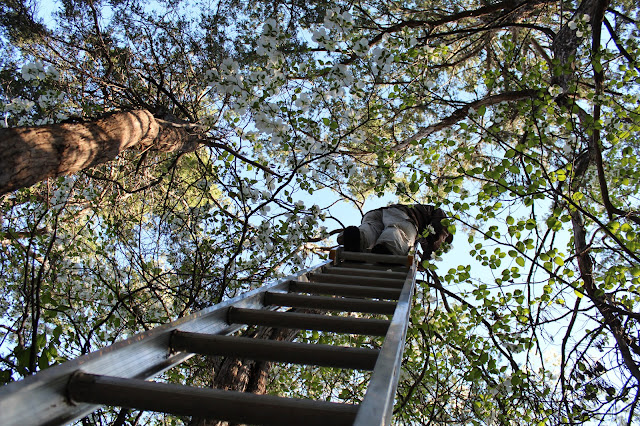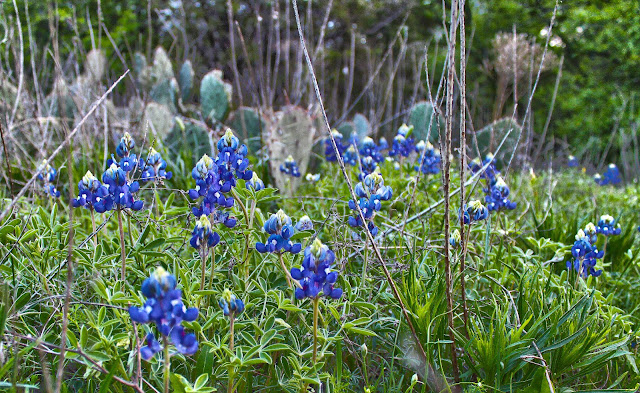Dogwood Canyon and Cedar Ridge Preserve — Hiking Into The Refugium
 |
| Climbing high in the tree tops of a century old Flowering Dogwood (Cornus florida) stand, Dogwood Canyon, Dallas County, Texas |
 |
| Master Naturalist Bill Holston climbing a ladder into the Dogwoods |
It sits three canyons, four creek crossings, two saddles, five hills and one pocket canyon away from the start of the hike. The refugium of dogwood trees hidden away for over a century. In an obscure canyon rarely visited, a place with no logical explanation of why these trees grow there we set our sights in the early pre-dawn light.
The pioneers that first settled this land called it the Cedar Mountains. A 100 million year old escarpment of limestone sitting on top of the Eagle Ford Shale running through Dallas County. This part of Texas is traditionally known as flat Blackland Prairie. A somewhat treeless native landscape with tall grasses and wildflowers. It attracted early settlers for the rich soils perfect for growing cotton and grain. The cedar ridges of southwest Dallas County are a stark contrast to that. Rolling limestone hills, steep ravines and cedar trees by the hundreds of thousands.
 |
| Cedar Ridge Preserve in the pre-dawn light of a Texas spring sunrise in the Black-capped Vireo Habitat Management Area |
The following covers a traverse of three different parks along the cedar ridges here. Cedar Ridge Preserve, Cedar Mountain Preserve and Dogwood Canyon Audubon Center. A hike this distance is not for most. I think many would likely get their fill of the ups and downs in just one of these spots. Hiking all of them in the same morning is a real unique experience. Walking the headwaters of different creeks that eventually feed into Mountain Creek, noting the differing vegetation from one hill to the next all at once gives one a comprehensive look at what makes these hills tick.
Locations and addresses:
Cedar Ridge Preserve 7171 Mountain Creek Parkway
Website:Cedar Ridge Preserve
Trail Map: Cedar Ridge Preserve Trail Map
Cedar Mountain Preserve 1300 W. FM 1382
Website: Dallas County Cedar Mountain
Trail Map: No official map available
Dogwood Canyon Audubon Center 1206 W FM 1382
Website:Dogwood Canyon Audubon Center
Trail Map: Dogwood Canyon Trail Map
No horses or mountain bikes allowed on those properties. Options for mountain biking in this area include the DORBA trail at Cedar Hill State Park and Big Cedar Wilderness. All five of these locations virtually interconnect in some way with trails. There should be roughly fifty miles of trails here across the five properties. Cedar Hill State Park and Dogwood Canyon both require an admission fee. Big Cedar is on private property and requires signed waivers.
Cedar Ridge Preserve — The Old Dallas Nature Center
 |
| Cedar Ridge Preserve’s pond in the early morning light |
Some might know this spot as the Dallas Nature Center. Started by the generous donation of Dave Fox of Fox & Jacobs, this land was purchased in 1975 by Mr Fox for the Greenhills Experimental Center. The previous owner, the US ambassador to Japan, Clayton Wyman ran it as a small getaway ranch. One of the preserve’s founders, Geoffrey Stanford lived on the property for a number of years.
In 1978 the foundation running the Greenhills Experimental Center changed the name to the Dallas Nature Center. It ran for a number of years on small budgets and was eventually consolidated into the Dallas County Open Space Program.
The Dallas Audubon Society has managed the now renamed Cedar Ridge Preserve since 2003. If you have not been there in awhile I think you will be pleased with the improvements to the property. Sitting on one of the highest points in Dallas at over 750 feet and with 600 some odd acres of terrain it has become a favorite spot of trail runners due to the looping trails and array of hills. Well made trails that flow with the contours make for good stabilized routes not prone to erosion.
 |
| Spring fed limestone creek where Austin Chalk meets the Eagle Ford Shale |
From the highest of overlooks to the lowest of water crossings Cedar Ridge Preserve is an interesting place unto itself. One unique spot known for a small drop off water feature might catch the eye of those with a geology background (seen above). Here the limestone of the Austin Chalk meets the shale of the Eagle Ford formation that sits below it. This picturesque spot is a great place to explain the White Rock Escarpment. The uplift here is a north to south feature beginning in Dallas County near the Trinity River and following the western edge of the Austin Chalk. The shale erodes at a faster rate than the overlying limestone creating the eroded hills, creek ravines and as we’ll see later remote hidden pockets of Texas few rarely see.
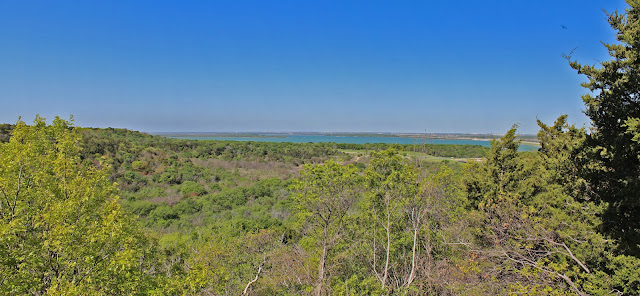 |
| View from the observation platform at Cedar Ridge Preserve looking west. Joe Pool Lake in the far distance. |
One of the high promontory points of Cedar Ridge features a two story observation deck with a commanding view of western Dallas County. From here on a clear day one can make out Joe Pool Lake, Six Flags Over Texas, Cowboys Stadium and Downtown Fort Worth.
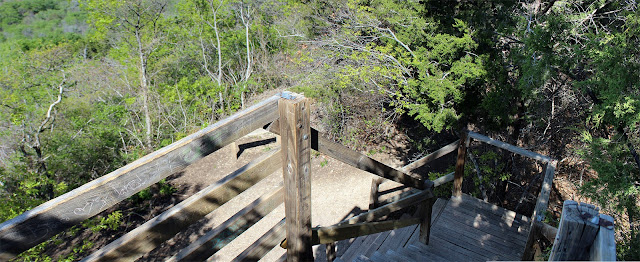 |
| Observation platform at Cedar Ridge Preserve |
 |
| Yucca pallida and Snake warning sign |
From this vantage point one can see Cedar Hill State Park and over to the far left the ridges that comprise Cedar Mountain Preserve and Dogwood Canyon.
Hiking from the ridges down to the Cattail pond on the property one crosses a number of ecological zones that house a variety of plants. Juniper, cactus and yucca dominate the high ridges. A little further down one sees the Mexican Buckeye, Mexican Plum, Sugar Hackberry and a variety of oaks including the Shin Oak.
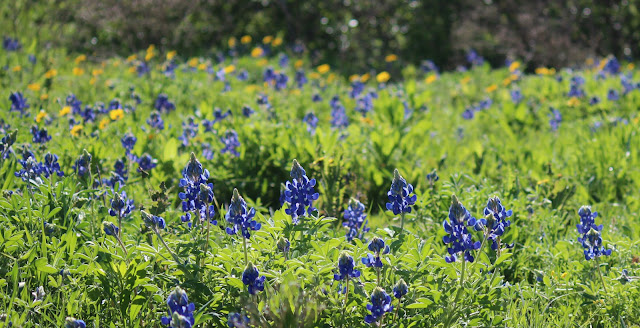 |
| Bluebonnets in full bloom at Cedar Ridge Preserve |
Leaving your vehicle behind at Cedar Ridge and crossing FM 1382 is pretty straightforward. An unlocked swing gate sits on the west side of the Cattail Pond fence line, a small gate designed for pedestrian traffic. Heading west by south crossing the ample median. Here Signal Hill in Cedar Hill comes into view. The tallest tower there is 1635 feet in height one of the tallest man made structures in the world. Native wildflowers carpet the hills here in the spring and make for a pleasant walk.
 |
| Hiking from Cedar Ridge Preserve to Cedar Mountain Preserve |
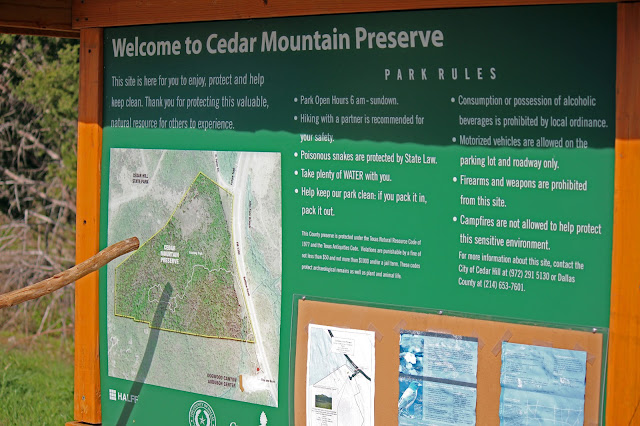 |
| Cedar Mountain Preserve Trail head |
Cedar Mountain Preserve sits south of Cedar Hill State Park and North of Dogwood Canyon Audubon Center. Smaller that it’s neighbors with a single trail that loops up to an overlook for a commanding view of the area. The flat low area near the trail head was once the site of a rental home most likely inhabited by 19th century sharecroppers. Archeology digs conducted here in the last several years point to 1860s-1900 when the home was occupied.
There was a parking lot for Cedar Mountain up until last year. In 2012 that parking lot access was combined into that of the Dogwood Canyon Audubon Center. Cedar Mountain is free to visit and unlike other nearby venues is open sunrise to sunset most of the year. If you want to see the sunset, this is the place to do it.
Dogwood Canyon Audubon Center
 |
| Under a canopy of dogwoods |
If one were visiting Texas for the first time or hosting house guests from afar wanting to see a Texas landscape, this is the place to go. Something strange happened up in the hidden canyons of this place. An ecological crossroads of sorts where all the different parts of the Lone Star State meet. The three hundred acres of scrabble canyons well represent Texas. From East Texas the dogwoods. From the north come the Trout Lilies and prairie flowers. From the West come the yucca and cactus. From the south the buckeye and junipers. From all points of the compass birds converge including the Black Capped Vireo, an endangered species.
 |
| Dogwood Canyon Audubon Center |
Just off FM1382 the visitor center for Dogwood Canyon sits on the site of an old transmission tower footprint that is incorporated into the new building site. Opened in September of 2011 the visitor center serves as an education building and information center.
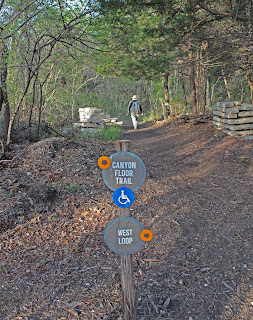 |
|||
| Trail junction behind the Visitor Center |
Couple of options in regards to the trails here. A lower trail, the Canyon Floor Trail sticks to a small tributary of Penn Creek that runs west to east through the canyon and out towards FM 1382. The ADA compliant trail affords easy access for those looking for something flat and without obstacles.
The other trail, the one of most interest to those reading this will be the West Loop/ West Rim Trail. This trail gradually climbs away from the canyon floor up a series of switchbacks to the canyon rim then follows that rim around to the west and north affording great views of Joe Pool Lake and points west in Tarrant County.
 |
| The forested canyon floor of Dogwood Canyon near the visitor center |
The creek running through here is named Penn Creek. Named for the original pioneer to first settle this area John Anderson Penn. He arrived in Dallas County in the mid 1850s with a wife and two sons. It’s believed he was first drawn to the area from Illinois by word of his California Gold Rush 49er friend Crawford Trees who owned large acreage in Dallas County. One of Penn’s sons, John Wesley Penn built his farm here, with 1859 as the founding date of the farm according to Texas Parks and Wildlife. The farm is still intact inside Cedar Hill State Park and serves as an outdoor museum to a time gone by. Many of the barns, homes and out buildings are still there.
John Wesley Penn had a thriving farm here for decades on Mountain Creek and the creek tributaries bearing his own name. He grew various crops in the lower areas, cut the meadows for hay and grazed cattle on the slopes to some extent. Mr Penn died at the hands of a rattlesnake, per the obituary below:
An Old Settler Dies From the Poisonous Effects of a Rattlesnake Bite.
Mr. John W. Penn, an old resident and respected farmer living on the mountain near Cedar Hill, in Dallas county, was bit by a rattle snake last Friday evening, from the effects of which, he died early Saturday morning. The fangs of the reptile were buried deep on the back of the hand, and as soon as he was bit, Mr. Penn declared he would never survive. His prediction was gradually verified as he poison settled deeper in his system and about midnight, he lost consciousness and became a raving maniac, four holding him in bed until death relieved his terrible suffering early Saturday morning. The snake struck the unfortunate man while he was in his field stooping over to pick up a rake from a rank growth of weeds. Mr. Penn had been living on the place twenty-five years, and he stated after he was bit that it was the largest snake he ever saw. He called to his son who was plowing in another portion of the field, who conveyed his father home. Stimulants and every remedy available were administered without effect. After its deadly work, the snake escaped in the high weeds. – June 25, 1888, Dallas Daily Herald
The rattlesnakes still grow large here. Sightings of very large rattlesnakes on the DORBA Trail at Cedar Hill State Park are very common. One of the more infamous photos that circulate the internet of a rattlesnake among bluebonnets was taken at Cedar Hill.
When Penn started his farm here, the hills were probably more of an open grass environment that kept trees and understory in check through infrequent wildfires. While it’s hard to say or call anything here man made, the large number of trees here now are a climax ecosystem due to lack of fire.
 |
| Switchback up the canyon |
Climbing up the canyon here, one can start to see things those old wildfires never touched. Maybe the fanning flames of wildfire never made it inside this canyon. Hard to tell. In the spring, with the canyon in full bloom you start seeing trees that belong much further south, like the Mexican Buckeye.
 |
| Mexican Buckeye Ungnadia speciosa on the West Rim Trail |
It would be fair to say that other nearby hills and canyons have Mexican Buckeye. Dogwood Canyon just has much more of it. That’s the theme here. More of everything. Not just variety but a profusion of population.
 |
| Trout Lily Erythronium albidum on the canyon floor |
Trout lilies are in great numbers here, some places they carpet the undulating terrain as if they were sown like winter wheat. This visit was too early for the hexalectris orchids that appear in May, they are here too. The trout lily and the hexalectris orchid are two plant species in the Dallas area for which man had no hand in planting. They also serve as telltales of land that has never seen a plow or development. The further back in the canyon you go the better it gets.
Man has been up here. Who knows when. Maybe half a century ago, most likely much longer than that, someone built a ramshackle cabin of a place way up on the slopes of the ridge. Far away from the world. This was long before any road or highway existed in the area, just a little country road to Cedar Hill.
The Old Cabin
The old cabin sits just off the main trail overlooking the upper reaches of Dogwood Canyon. Built of cedar and corrugated metal siding the untouched building here is a great look into the past. Unapologetically out of fashion, a building in such state takes on a life of it’s own.
 |
| View of the canyon near the cabin |
 |
| Interior of the “Old Cabin” at Dogwood Canyon Audubon Center |
The remote nature of the cabin, the rustic looks of something only time can wear on a structure and the unique construction make this one cool little place worth visiting. The interior suggests the current structure is a rebuild of a previous building. The joints, eaves and framing suggest a similar building once sat nearby and reconstituted into what we see today. Turn of the last century with additions maybe in the Depression era and post World War II. An old school desk, oil drum stove and a sleeping loft dominate the interior. It would be interesting to learn who used this. A retreat and escape of some kind for sure. Lacking the hallmarks of a tack shed, feed storage room or rental house this was a home away from it all for some lucky soul. Fortress of solitude, getaway, take your pick.
The Hurt Family
 |
| David Hurt at Dogwood Canyon April 2013 |
This would be a good point to mention the family whose donation served as the nucleus for Dogwood Canyon, David and Kim Hurt. They purchased a tract of the canyon here with intentions of building a dream home nestled in the high canyon. In 1999 on a hike in the canyon, David Hurt discovered a number of the special qualities of the woods here, including the special dogwood grove.
Through their special donation, the land here was preserved and additional tracts purchased to mushroom into 200+ acres. Parcel by parcel the jigsaw pieces of land gel together to form a great sanctuary.
It would be hard to find fault in someone who wanted to keep a place like this to themselves. Sharing it with the public and working towards preserving it is really an exceptional note of altruism.
Finding The Dogwoods
 I have no idea how David Hurt found the dogwoods. They are not on a trail. Not up the bank of a creek. They sit in some mysterious place that is hard to describe.
I have no idea how David Hurt found the dogwoods. They are not on a trail. Not up the bank of a creek. They sit in some mysterious place that is hard to describe.
Leaving the marked trail even Master Naturalist Bill Holston had some reservation about finding the spot. He had been there before but the route to get there involves a great bit of sleuthing.
Ecologists call the place we are head a Refugium. A quirk of the natural world where time and history bypass a place leaving old stands of plants and animals to live in a micro environment. A location of an isolated or relict population of a once widespread animal or plant species. Great Texas examples are the Lost Maples in the Hill Country and Texas Blind Salamanders in San Marcos.
Heading down slope and into the canyon the dramatic difference in the plants becomes apparent. Mushrooms, thick mosses and trout lilies abound.
 |
| Penn Creek tributary high in the canyon |
Headed down a couple draws and finally reaching a small chalk creek the bright morning sun barely penetrates down here. Up two more box draws and a number of blown down juniper one second guesses if they are on the right path. Then you see them. The trees for which the canyon gets the name.
 |
| Flowering Dogwood (Cornus florida) |
The Flowering Dogwood (Cornus florida) is best known for the white petal-like flat bracts that give the appearance of a single large flower. The real flower of the dogwood are the yellowish green compacted clusters in the center.
Flowering dogwoods are small trees usually growing to 15-30 feet in height and are known as an understory tree in most Southern forests. The trees in Dogwood Canyon fit that bill. The stand of trees sit on somewhat flat ground at the head of a box canyon draw of sorts growing among leafy detritus of nearby oaks.
The odd bedfellow to the mix are the alkaline loving juniper that grow side by side along the dogwoods. Really strange to see as the two typically prefer different soils in which to thrive.
Difficult to explain how the trees came to thrive in such an area. Some say these trees are over a century old. Deep in a far away canyon with no buildings or farms existing in the nearby vicinity during any time in the past one wonders if humans or a true marooned plant species exist here. Lots of good questions but no good answers pointing any direction. Shrug your shoulders and just accept what you are seeing is unique. There is no other place like it.
The closest native stand of Flowering Dogwoods sit some distance east in Van Zandt county. A traditional understory tree of acidic soils the head scratching commences wondering how the trees not only came to be here but seem to thrive in an alkaline soil.
The best way to see these large dogwoods is to climb up into their canopy. Using a large ladder supported on the trunk of a juniper tree we climbed high into the branches.
The view from above is exceptional. Looking down at the forest below and the far horizon in the distance one gains a new perspective for the size of the trees here.
 |
| Looking down on the forest floor far below |
Most of the photos here were taken up in the canopy 15-20 feet or so climbing the ladder
A real under the radar gem of a place. I would have a hard time finding it again as no trail exists to the spot. I think plans are in the works to open up some kind of more formal trail to the spot. If that never happens I think that would be a cool thing.
 |
| West Rim Trail view of Joe Pool Lake |
 |
| Hummingbird in a Shin Oak at Dogwood Canyon |
Few places combine so many species of birds and plants like the cedar ridges down in Southern Dallas. Hard pressed to find something with more.
Our hike back saw more birds than the walk in. Hummingbirds fresh from Mexico, honeybees abuzz among the bluebonnets and buckeyes. A real eye opener to a place so many people have never been.
Cedar Ridge Preserve for miles of hiking trails, Cedar Mountain for great free sunsets and Dogwood Canyon for an overdose on what Texas is all about.








